Efficacy of Occupational Therapy for Dementia: Portfolio Report
VerifiedAdded on 2022/11/16
|20
|5817
|52
Report
AI Summary
This report presents a critical reflective portfolio on the efficacy of occupational therapy for individuals with dementia, particularly focusing on older adults. The student explores Cognitive Stimulation Therapy (CST) as a non-pharmacological intervention, detailing the formation and dynamics of an occupational therapy team, including the roles of individual members and the stages of group development. The report highlights the potential of therapeutic occupations, such as aromatherapy and reminiscence activities, to enhance cognitive skills, memory, and social engagement. It also analyzes the application of the Gibb’s reflective model and relevant theoretical frameworks, such as group dynamics and reminiscence theory, to evaluate the effectiveness of the intervention. The student reflects on personal learning experiences, challenges encountered, and areas for improvement in therapeutic practice. The report emphasizes the importance of interdisciplinary teamwork, communication, and the impact of environmental factors on patient well-being, providing a comprehensive overview of occupational therapy's role in dementia care and is available on Desklib.
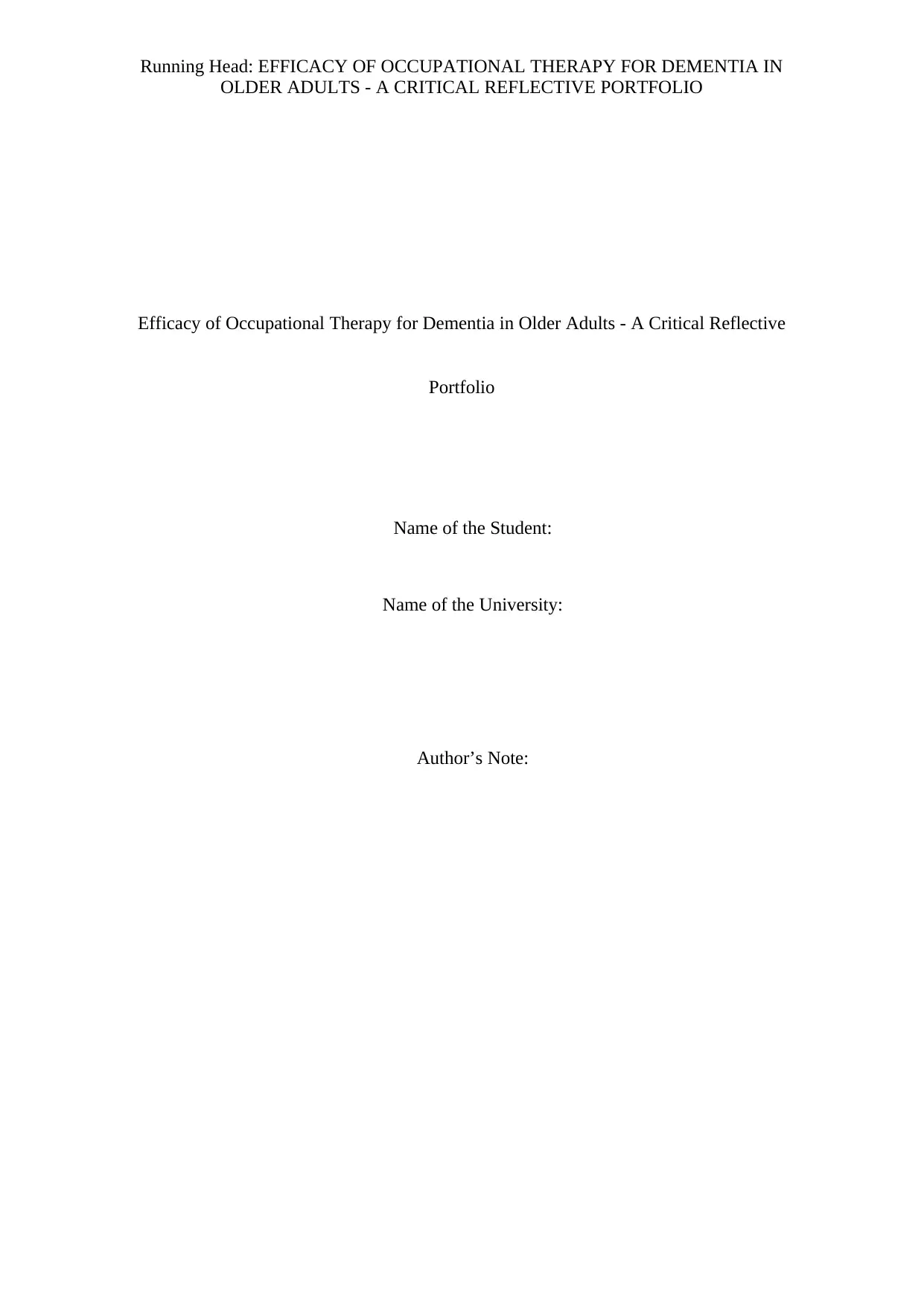
Running Head: EFFICACY OF OCCUPATIONAL THERAPY FOR DEMENTIA IN
OLDER ADULTS - A CRITICAL REFLECTIVE PORTFOLIO
Efficacy of Occupational Therapy for Dementia in Older Adults - A Critical Reflective
Portfolio
Name of the Student:
Name of the University:
Author’s Note:
OLDER ADULTS - A CRITICAL REFLECTIVE PORTFOLIO
Efficacy of Occupational Therapy for Dementia in Older Adults - A Critical Reflective
Portfolio
Name of the Student:
Name of the University:
Author’s Note:
Paraphrase This Document
Need a fresh take? Get an instant paraphrase of this document with our AI Paraphraser
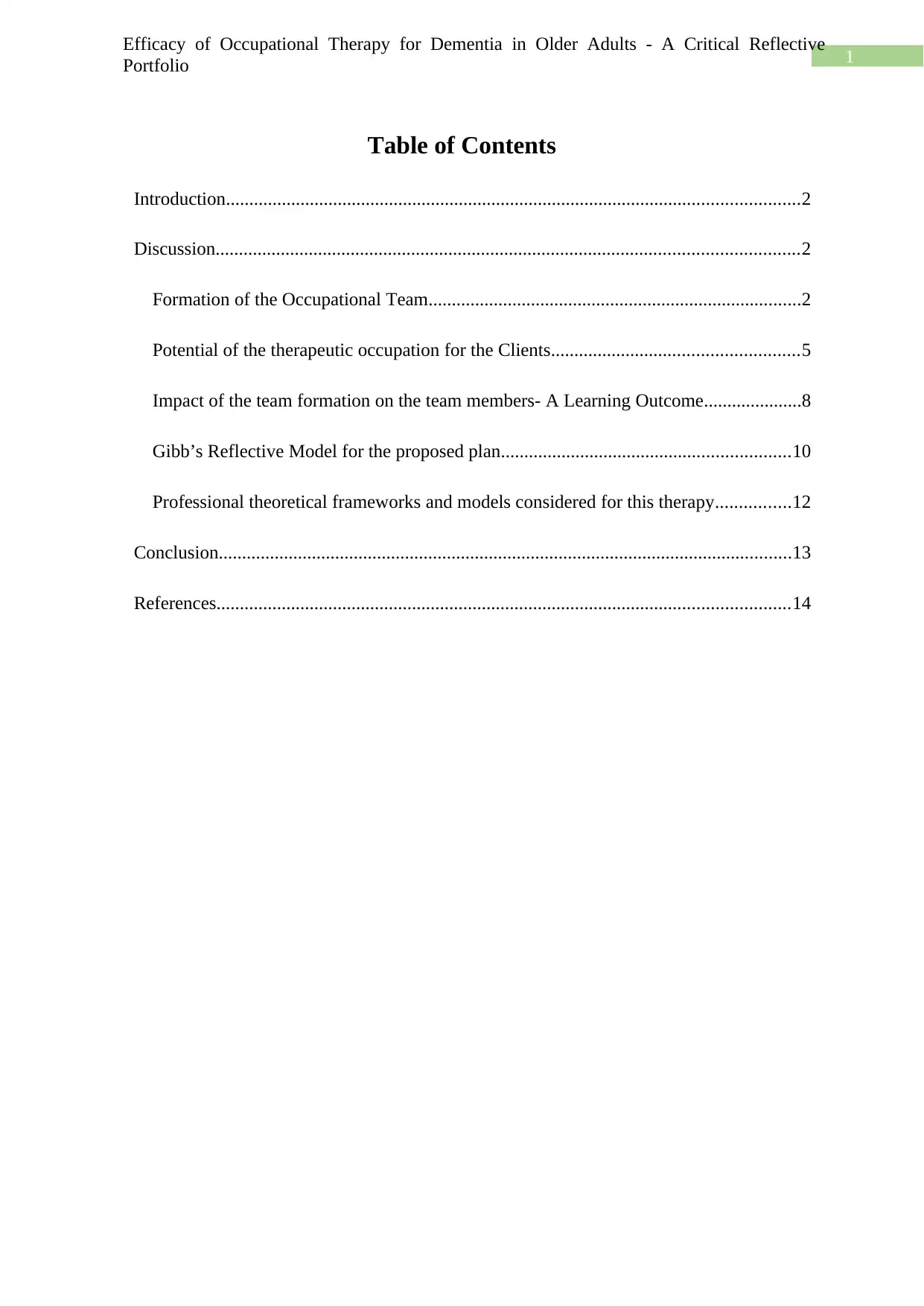
1
Efficacy of Occupational Therapy for Dementia in Older Adults - A Critical Reflective
Portfolio
Table of Contents
Introduction...........................................................................................................................2
Discussion.............................................................................................................................2
Formation of the Occupational Team................................................................................2
Potential of the therapeutic occupation for the Clients.....................................................5
Impact of the team formation on the team members- A Learning Outcome.....................8
Gibb’s Reflective Model for the proposed plan..............................................................10
Professional theoretical frameworks and models considered for this therapy................12
Conclusion...........................................................................................................................13
References...........................................................................................................................14
Efficacy of Occupational Therapy for Dementia in Older Adults - A Critical Reflective
Portfolio
Table of Contents
Introduction...........................................................................................................................2
Discussion.............................................................................................................................2
Formation of the Occupational Team................................................................................2
Potential of the therapeutic occupation for the Clients.....................................................5
Impact of the team formation on the team members- A Learning Outcome.....................8
Gibb’s Reflective Model for the proposed plan..............................................................10
Professional theoretical frameworks and models considered for this therapy................12
Conclusion...........................................................................................................................13
References...........................................................................................................................14
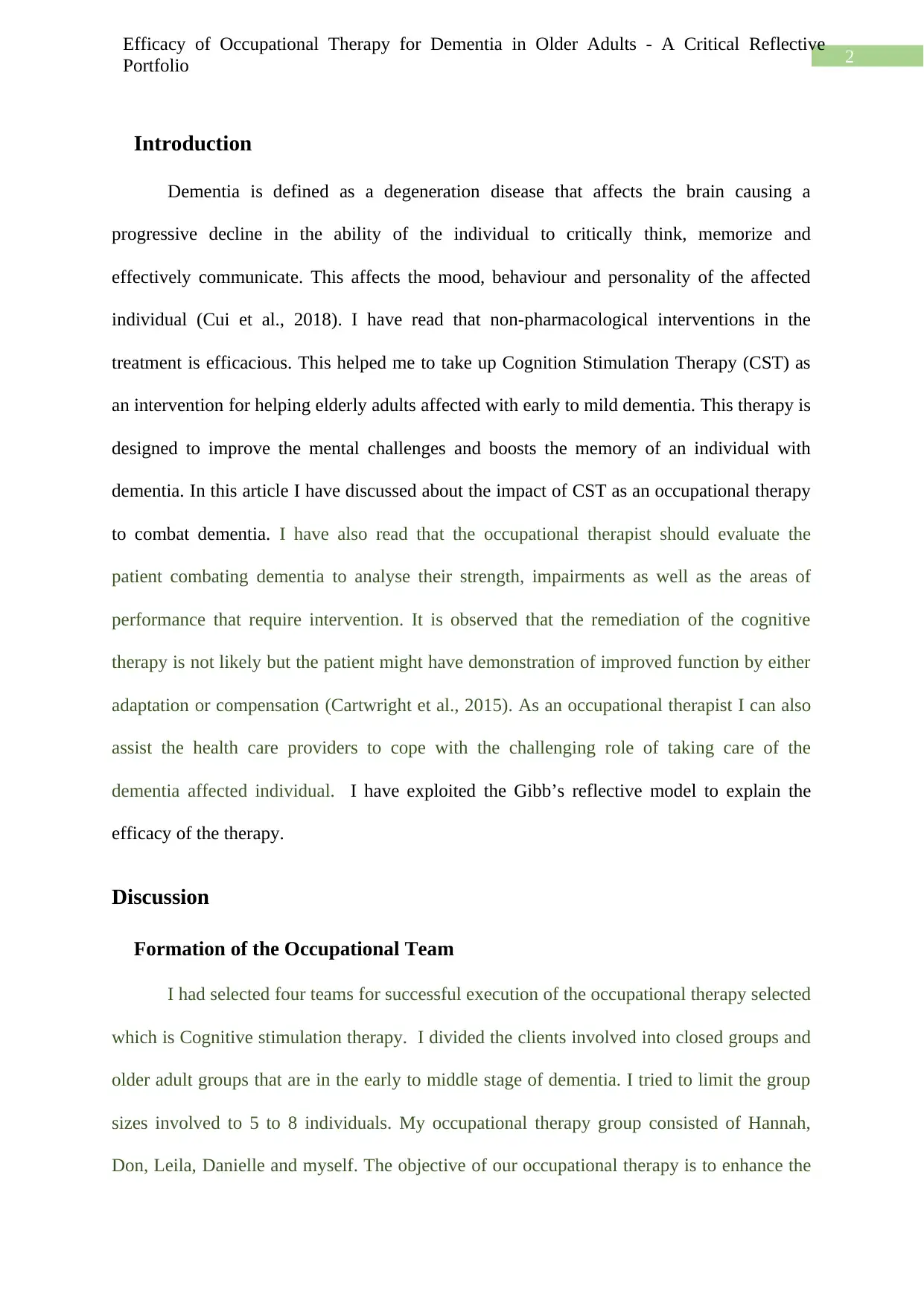
2
Efficacy of Occupational Therapy for Dementia in Older Adults - A Critical Reflective
Portfolio
Introduction
Dementia is defined as a degeneration disease that affects the brain causing a
progressive decline in the ability of the individual to critically think, memorize and
effectively communicate. This affects the mood, behaviour and personality of the affected
individual (Cui et al., 2018). I have read that non-pharmacological interventions in the
treatment is efficacious. This helped me to take up Cognition Stimulation Therapy (CST) as
an intervention for helping elderly adults affected with early to mild dementia. This therapy is
designed to improve the mental challenges and boosts the memory of an individual with
dementia. In this article I have discussed about the impact of CST as an occupational therapy
to combat dementia. I have also read that the occupational therapist should evaluate the
patient combating dementia to analyse their strength, impairments as well as the areas of
performance that require intervention. It is observed that the remediation of the cognitive
therapy is not likely but the patient might have demonstration of improved function by either
adaptation or compensation (Cartwright et al., 2015). As an occupational therapist I can also
assist the health care providers to cope with the challenging role of taking care of the
dementia affected individual. I have exploited the Gibb’s reflective model to explain the
efficacy of the therapy.
Discussion
Formation of the Occupational Team
I had selected four teams for successful execution of the occupational therapy selected
which is Cognitive stimulation therapy. I divided the clients involved into closed groups and
older adult groups that are in the early to middle stage of dementia. I tried to limit the group
sizes involved to 5 to 8 individuals. My occupational therapy group consisted of Hannah,
Don, Leila, Danielle and myself. The objective of our occupational therapy is to enhance the
Efficacy of Occupational Therapy for Dementia in Older Adults - A Critical Reflective
Portfolio
Introduction
Dementia is defined as a degeneration disease that affects the brain causing a
progressive decline in the ability of the individual to critically think, memorize and
effectively communicate. This affects the mood, behaviour and personality of the affected
individual (Cui et al., 2018). I have read that non-pharmacological interventions in the
treatment is efficacious. This helped me to take up Cognition Stimulation Therapy (CST) as
an intervention for helping elderly adults affected with early to mild dementia. This therapy is
designed to improve the mental challenges and boosts the memory of an individual with
dementia. In this article I have discussed about the impact of CST as an occupational therapy
to combat dementia. I have also read that the occupational therapist should evaluate the
patient combating dementia to analyse their strength, impairments as well as the areas of
performance that require intervention. It is observed that the remediation of the cognitive
therapy is not likely but the patient might have demonstration of improved function by either
adaptation or compensation (Cartwright et al., 2015). As an occupational therapist I can also
assist the health care providers to cope with the challenging role of taking care of the
dementia affected individual. I have exploited the Gibb’s reflective model to explain the
efficacy of the therapy.
Discussion
Formation of the Occupational Team
I had selected four teams for successful execution of the occupational therapy selected
which is Cognitive stimulation therapy. I divided the clients involved into closed groups and
older adult groups that are in the early to middle stage of dementia. I tried to limit the group
sizes involved to 5 to 8 individuals. My occupational therapy group consisted of Hannah,
Don, Leila, Danielle and myself. The objective of our occupational therapy is to enhance the
⊘ This is a preview!⊘
Do you want full access?
Subscribe today to unlock all pages.

Trusted by 1+ million students worldwide
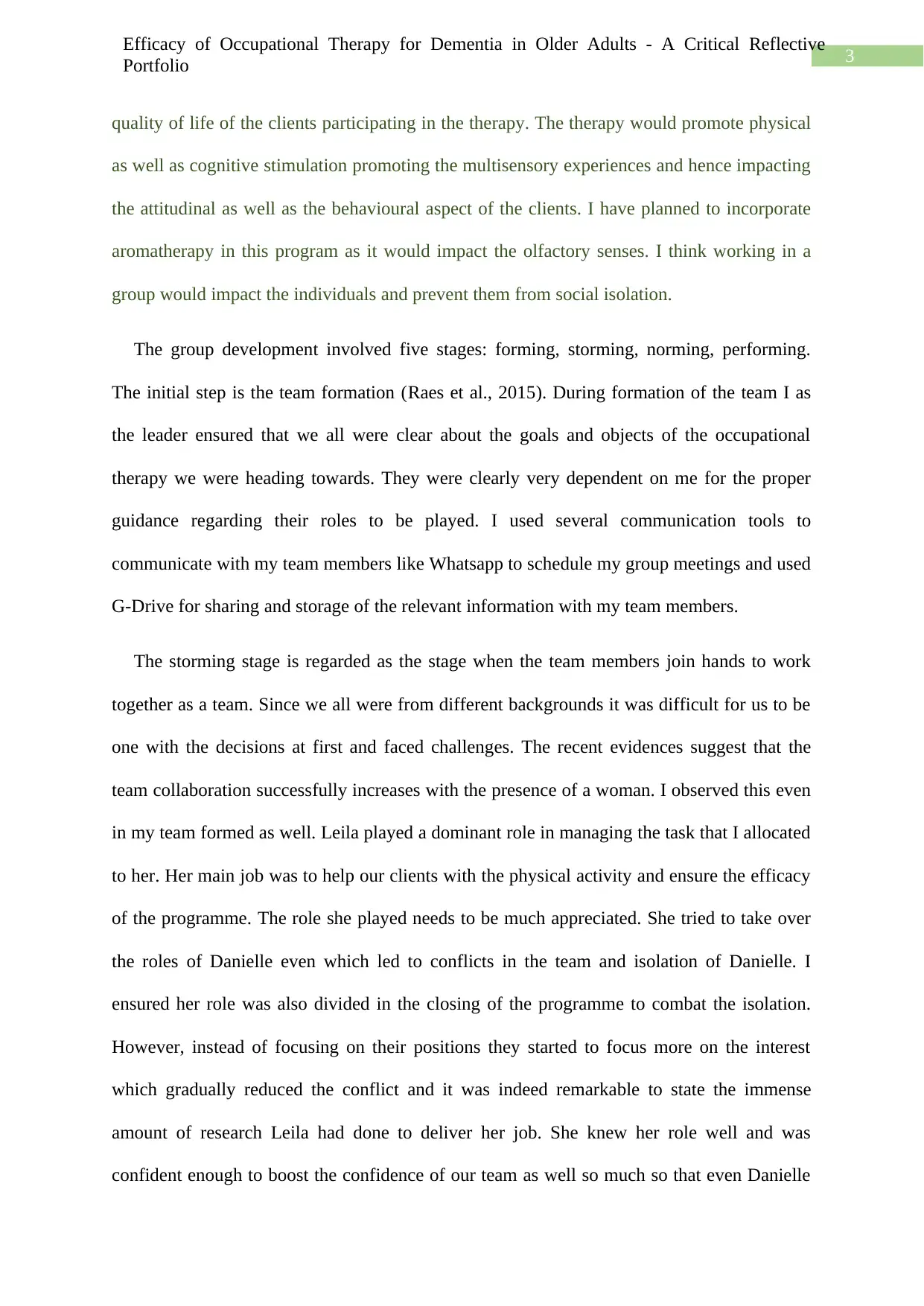
3
Efficacy of Occupational Therapy for Dementia in Older Adults - A Critical Reflective
Portfolio
quality of life of the clients participating in the therapy. The therapy would promote physical
as well as cognitive stimulation promoting the multisensory experiences and hence impacting
the attitudinal as well as the behavioural aspect of the clients. I have planned to incorporate
aromatherapy in this program as it would impact the olfactory senses. I think working in a
group would impact the individuals and prevent them from social isolation.
The group development involved five stages: forming, storming, norming, performing.
The initial step is the team formation (Raes et al., 2015). During formation of the team I as
the leader ensured that we all were clear about the goals and objects of the occupational
therapy we were heading towards. They were clearly very dependent on me for the proper
guidance regarding their roles to be played. I used several communication tools to
communicate with my team members like Whatsapp to schedule my group meetings and used
G-Drive for sharing and storage of the relevant information with my team members.
The storming stage is regarded as the stage when the team members join hands to work
together as a team. Since we all were from different backgrounds it was difficult for us to be
one with the decisions at first and faced challenges. The recent evidences suggest that the
team collaboration successfully increases with the presence of a woman. I observed this even
in my team formed as well. Leila played a dominant role in managing the task that I allocated
to her. Her main job was to help our clients with the physical activity and ensure the efficacy
of the programme. The role she played needs to be much appreciated. She tried to take over
the roles of Danielle even which led to conflicts in the team and isolation of Danielle. I
ensured her role was also divided in the closing of the programme to combat the isolation.
However, instead of focusing on their positions they started to focus more on the interest
which gradually reduced the conflict and it was indeed remarkable to state the immense
amount of research Leila had done to deliver her job. She knew her role well and was
confident enough to boost the confidence of our team as well so much so that even Danielle
Efficacy of Occupational Therapy for Dementia in Older Adults - A Critical Reflective
Portfolio
quality of life of the clients participating in the therapy. The therapy would promote physical
as well as cognitive stimulation promoting the multisensory experiences and hence impacting
the attitudinal as well as the behavioural aspect of the clients. I have planned to incorporate
aromatherapy in this program as it would impact the olfactory senses. I think working in a
group would impact the individuals and prevent them from social isolation.
The group development involved five stages: forming, storming, norming, performing.
The initial step is the team formation (Raes et al., 2015). During formation of the team I as
the leader ensured that we all were clear about the goals and objects of the occupational
therapy we were heading towards. They were clearly very dependent on me for the proper
guidance regarding their roles to be played. I used several communication tools to
communicate with my team members like Whatsapp to schedule my group meetings and used
G-Drive for sharing and storage of the relevant information with my team members.
The storming stage is regarded as the stage when the team members join hands to work
together as a team. Since we all were from different backgrounds it was difficult for us to be
one with the decisions at first and faced challenges. The recent evidences suggest that the
team collaboration successfully increases with the presence of a woman. I observed this even
in my team formed as well. Leila played a dominant role in managing the task that I allocated
to her. Her main job was to help our clients with the physical activity and ensure the efficacy
of the programme. The role she played needs to be much appreciated. She tried to take over
the roles of Danielle even which led to conflicts in the team and isolation of Danielle. I
ensured her role was also divided in the closing of the programme to combat the isolation.
However, instead of focusing on their positions they started to focus more on the interest
which gradually reduced the conflict and it was indeed remarkable to state the immense
amount of research Leila had done to deliver her job. She knew her role well and was
confident enough to boost the confidence of our team as well so much so that even Danielle
Paraphrase This Document
Need a fresh take? Get an instant paraphrase of this document with our AI Paraphraser
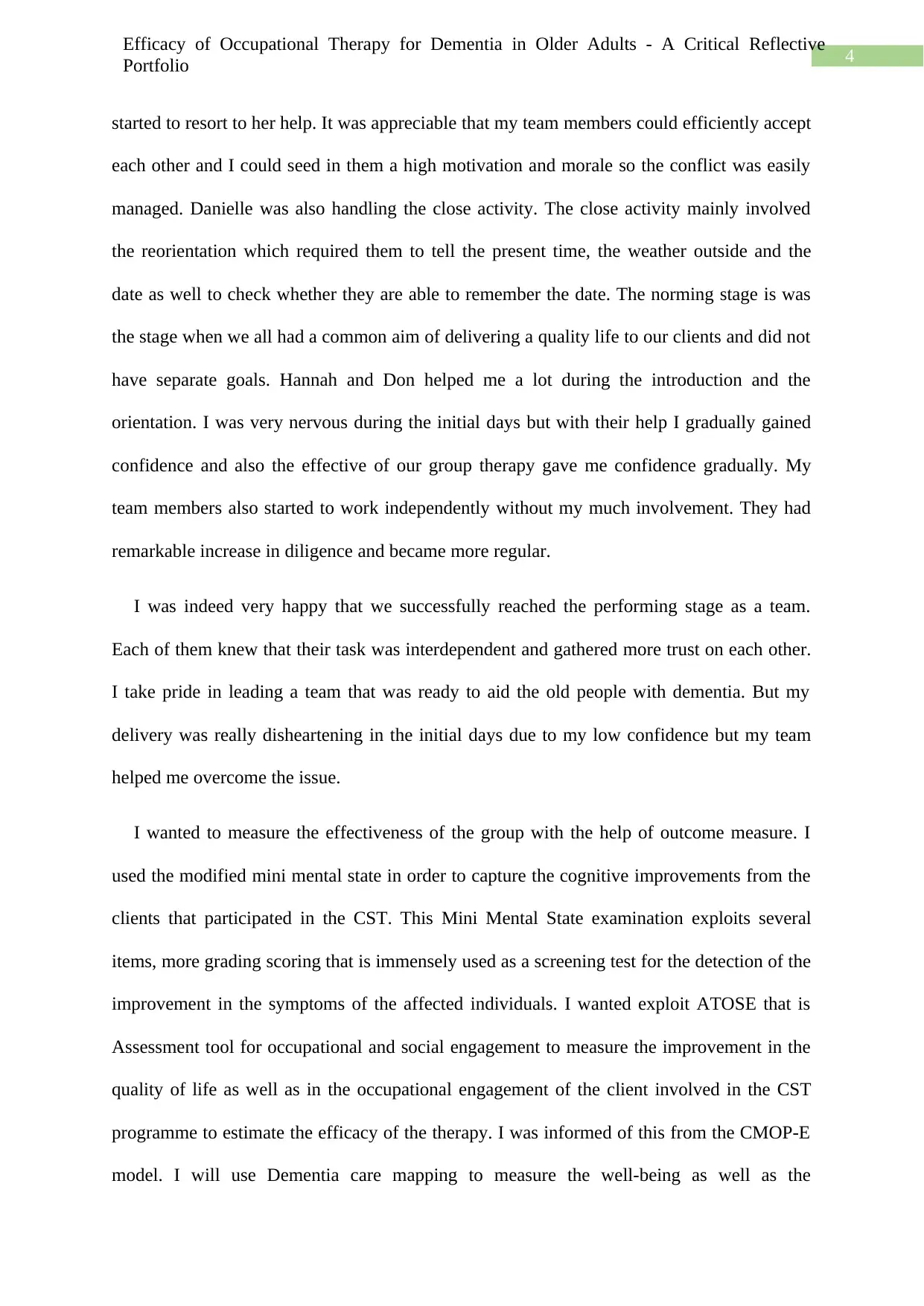
4
Efficacy of Occupational Therapy for Dementia in Older Adults - A Critical Reflective
Portfolio
started to resort to her help. It was appreciable that my team members could efficiently accept
each other and I could seed in them a high motivation and morale so the conflict was easily
managed. Danielle was also handling the close activity. The close activity mainly involved
the reorientation which required them to tell the present time, the weather outside and the
date as well to check whether they are able to remember the date. The norming stage is was
the stage when we all had a common aim of delivering a quality life to our clients and did not
have separate goals. Hannah and Don helped me a lot during the introduction and the
orientation. I was very nervous during the initial days but with their help I gradually gained
confidence and also the effective of our group therapy gave me confidence gradually. My
team members also started to work independently without my much involvement. They had
remarkable increase in diligence and became more regular.
I was indeed very happy that we successfully reached the performing stage as a team.
Each of them knew that their task was interdependent and gathered more trust on each other.
I take pride in leading a team that was ready to aid the old people with dementia. But my
delivery was really disheartening in the initial days due to my low confidence but my team
helped me overcome the issue.
I wanted to measure the effectiveness of the group with the help of outcome measure. I
used the modified mini mental state in order to capture the cognitive improvements from the
clients that participated in the CST. This Mini Mental State examination exploits several
items, more grading scoring that is immensely used as a screening test for the detection of the
improvement in the symptoms of the affected individuals. I wanted exploit ATOSE that is
Assessment tool for occupational and social engagement to measure the improvement in the
quality of life as well as in the occupational engagement of the client involved in the CST
programme to estimate the efficacy of the therapy. I was informed of this from the CMOP-E
model. I will use Dementia care mapping to measure the well-being as well as the
Efficacy of Occupational Therapy for Dementia in Older Adults - A Critical Reflective
Portfolio
started to resort to her help. It was appreciable that my team members could efficiently accept
each other and I could seed in them a high motivation and morale so the conflict was easily
managed. Danielle was also handling the close activity. The close activity mainly involved
the reorientation which required them to tell the present time, the weather outside and the
date as well to check whether they are able to remember the date. The norming stage is was
the stage when we all had a common aim of delivering a quality life to our clients and did not
have separate goals. Hannah and Don helped me a lot during the introduction and the
orientation. I was very nervous during the initial days but with their help I gradually gained
confidence and also the effective of our group therapy gave me confidence gradually. My
team members also started to work independently without my much involvement. They had
remarkable increase in diligence and became more regular.
I was indeed very happy that we successfully reached the performing stage as a team.
Each of them knew that their task was interdependent and gathered more trust on each other.
I take pride in leading a team that was ready to aid the old people with dementia. But my
delivery was really disheartening in the initial days due to my low confidence but my team
helped me overcome the issue.
I wanted to measure the effectiveness of the group with the help of outcome measure. I
used the modified mini mental state in order to capture the cognitive improvements from the
clients that participated in the CST. This Mini Mental State examination exploits several
items, more grading scoring that is immensely used as a screening test for the detection of the
improvement in the symptoms of the affected individuals. I wanted exploit ATOSE that is
Assessment tool for occupational and social engagement to measure the improvement in the
quality of life as well as in the occupational engagement of the client involved in the CST
programme to estimate the efficacy of the therapy. I was informed of this from the CMOP-E
model. I will use Dementia care mapping to measure the well-being as well as the
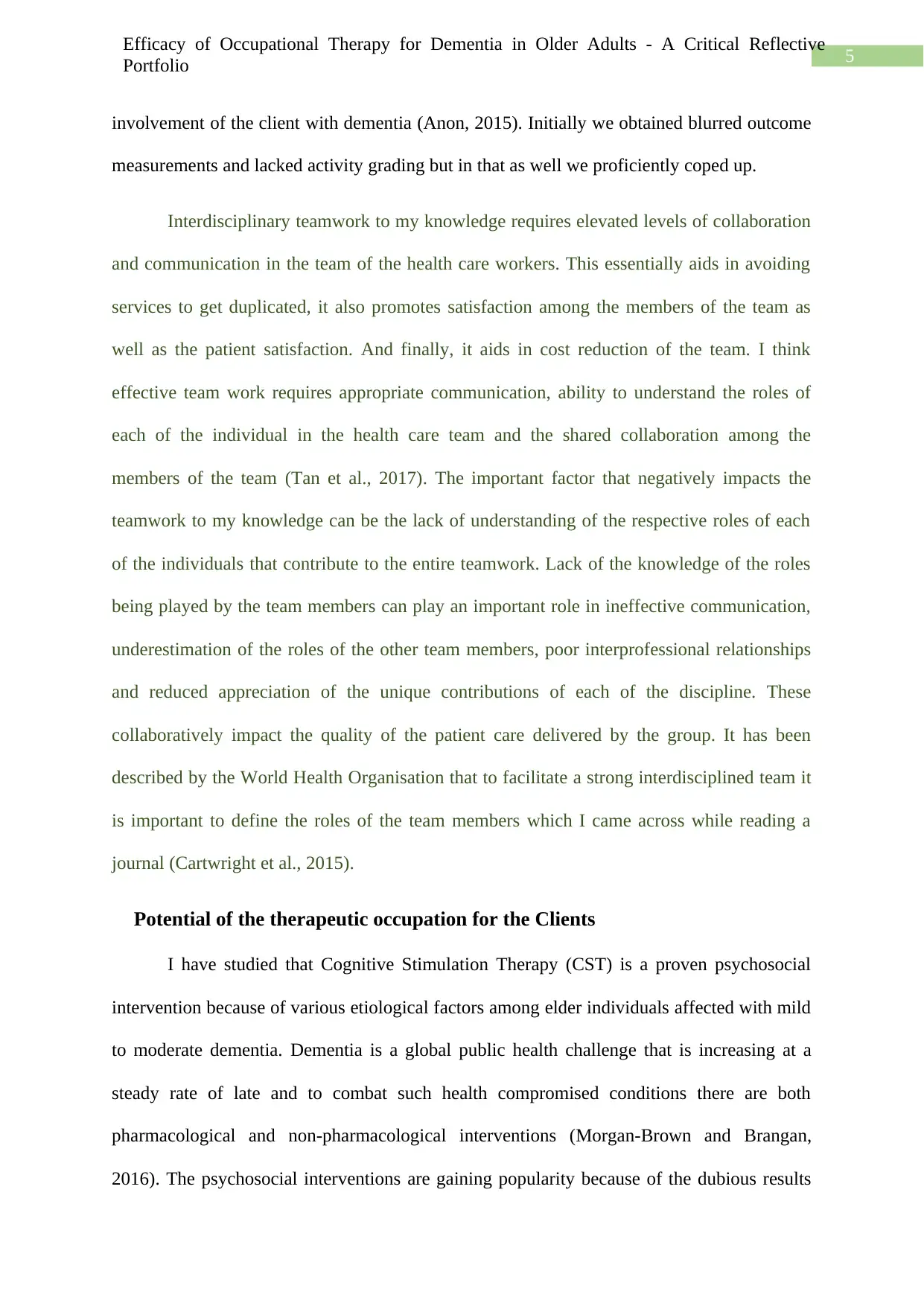
5
Efficacy of Occupational Therapy for Dementia in Older Adults - A Critical Reflective
Portfolio
involvement of the client with dementia (Anon, 2015). Initially we obtained blurred outcome
measurements and lacked activity grading but in that as well we proficiently coped up.
Interdisciplinary teamwork to my knowledge requires elevated levels of collaboration
and communication in the team of the health care workers. This essentially aids in avoiding
services to get duplicated, it also promotes satisfaction among the members of the team as
well as the patient satisfaction. And finally, it aids in cost reduction of the team. I think
effective team work requires appropriate communication, ability to understand the roles of
each of the individual in the health care team and the shared collaboration among the
members of the team (Tan et al., 2017). The important factor that negatively impacts the
teamwork to my knowledge can be the lack of understanding of the respective roles of each
of the individuals that contribute to the entire teamwork. Lack of the knowledge of the roles
being played by the team members can play an important role in ineffective communication,
underestimation of the roles of the other team members, poor interprofessional relationships
and reduced appreciation of the unique contributions of each of the discipline. These
collaboratively impact the quality of the patient care delivered by the group. It has been
described by the World Health Organisation that to facilitate a strong interdisciplined team it
is important to define the roles of the team members which I came across while reading a
journal (Cartwright et al., 2015).
Potential of the therapeutic occupation for the Clients
I have studied that Cognitive Stimulation Therapy (CST) is a proven psychosocial
intervention because of various etiological factors among elder individuals affected with mild
to moderate dementia. Dementia is a global public health challenge that is increasing at a
steady rate of late and to combat such health compromised conditions there are both
pharmacological and non-pharmacological interventions (Morgan-Brown and Brangan,
2016). The psychosocial interventions are gaining popularity because of the dubious results
Efficacy of Occupational Therapy for Dementia in Older Adults - A Critical Reflective
Portfolio
involvement of the client with dementia (Anon, 2015). Initially we obtained blurred outcome
measurements and lacked activity grading but in that as well we proficiently coped up.
Interdisciplinary teamwork to my knowledge requires elevated levels of collaboration
and communication in the team of the health care workers. This essentially aids in avoiding
services to get duplicated, it also promotes satisfaction among the members of the team as
well as the patient satisfaction. And finally, it aids in cost reduction of the team. I think
effective team work requires appropriate communication, ability to understand the roles of
each of the individual in the health care team and the shared collaboration among the
members of the team (Tan et al., 2017). The important factor that negatively impacts the
teamwork to my knowledge can be the lack of understanding of the respective roles of each
of the individuals that contribute to the entire teamwork. Lack of the knowledge of the roles
being played by the team members can play an important role in ineffective communication,
underestimation of the roles of the other team members, poor interprofessional relationships
and reduced appreciation of the unique contributions of each of the discipline. These
collaboratively impact the quality of the patient care delivered by the group. It has been
described by the World Health Organisation that to facilitate a strong interdisciplined team it
is important to define the roles of the team members which I came across while reading a
journal (Cartwright et al., 2015).
Potential of the therapeutic occupation for the Clients
I have studied that Cognitive Stimulation Therapy (CST) is a proven psychosocial
intervention because of various etiological factors among elder individuals affected with mild
to moderate dementia. Dementia is a global public health challenge that is increasing at a
steady rate of late and to combat such health compromised conditions there are both
pharmacological and non-pharmacological interventions (Morgan-Brown and Brangan,
2016). The psychosocial interventions are gaining popularity because of the dubious results
⊘ This is a preview!⊘
Do you want full access?
Subscribe today to unlock all pages.

Trusted by 1+ million students worldwide
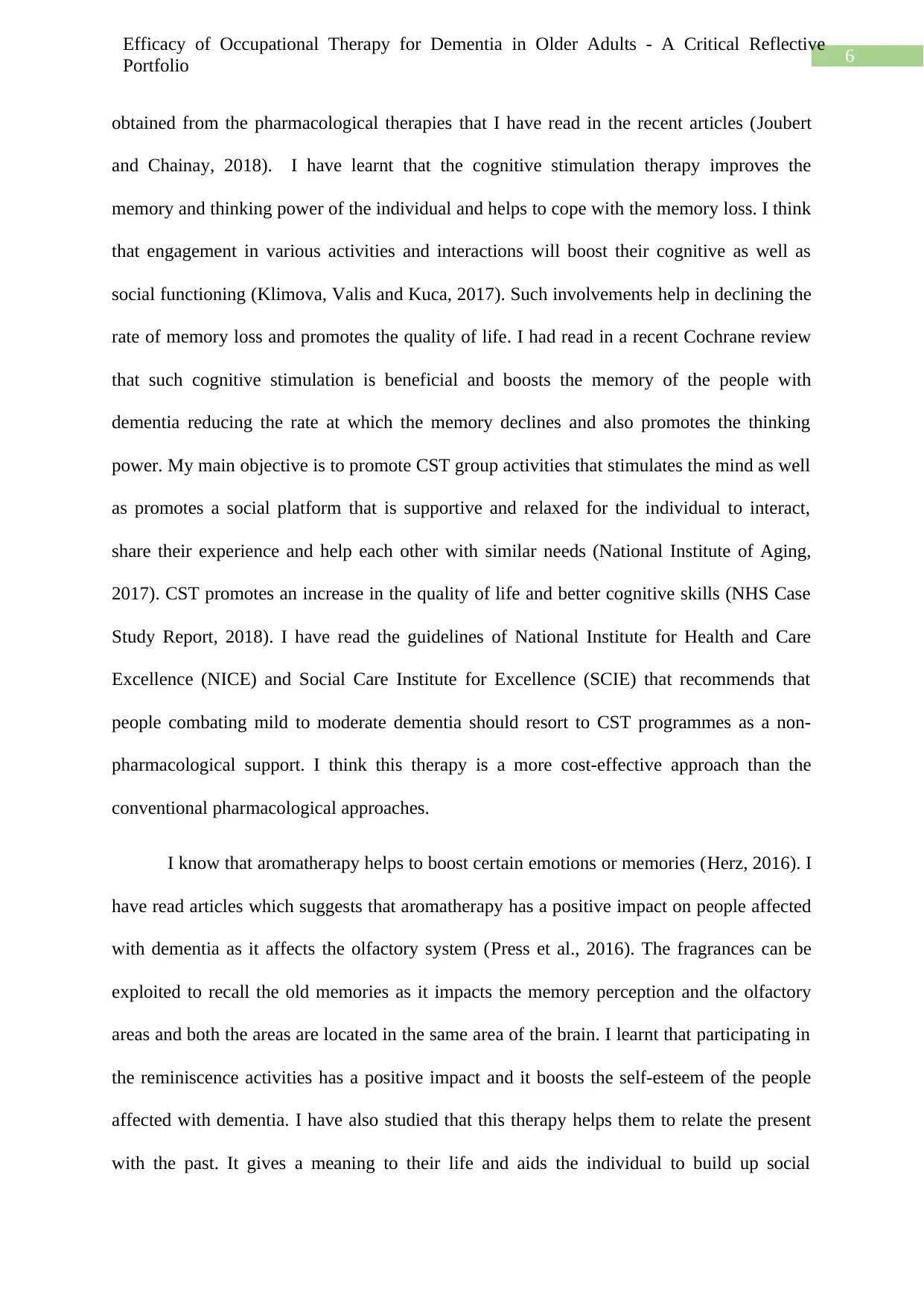
6
Efficacy of Occupational Therapy for Dementia in Older Adults - A Critical Reflective
Portfolio
obtained from the pharmacological therapies that I have read in the recent articles (Joubert
and Chainay, 2018). I have learnt that the cognitive stimulation therapy improves the
memory and thinking power of the individual and helps to cope with the memory loss. I think
that engagement in various activities and interactions will boost their cognitive as well as
social functioning (Klimova, Valis and Kuca, 2017). Such involvements help in declining the
rate of memory loss and promotes the quality of life. I had read in a recent Cochrane review
that such cognitive stimulation is beneficial and boosts the memory of the people with
dementia reducing the rate at which the memory declines and also promotes the thinking
power. My main objective is to promote CST group activities that stimulates the mind as well
as promotes a social platform that is supportive and relaxed for the individual to interact,
share their experience and help each other with similar needs (National Institute of Aging,
2017). CST promotes an increase in the quality of life and better cognitive skills (NHS Case
Study Report, 2018). I have read the guidelines of National Institute for Health and Care
Excellence (NICE) and Social Care Institute for Excellence (SCIE) that recommends that
people combating mild to moderate dementia should resort to CST programmes as a non-
pharmacological support. I think this therapy is a more cost-effective approach than the
conventional pharmacological approaches.
I know that aromatherapy helps to boost certain emotions or memories (Herz, 2016). I
have read articles which suggests that aromatherapy has a positive impact on people affected
with dementia as it affects the olfactory system (Press et al., 2016). The fragrances can be
exploited to recall the old memories as it impacts the memory perception and the olfactory
areas and both the areas are located in the same area of the brain. I learnt that participating in
the reminiscence activities has a positive impact and it boosts the self-esteem of the people
affected with dementia. I have also studied that this therapy helps them to relate the present
with the past. It gives a meaning to their life and aids the individual to build up social
Efficacy of Occupational Therapy for Dementia in Older Adults - A Critical Reflective
Portfolio
obtained from the pharmacological therapies that I have read in the recent articles (Joubert
and Chainay, 2018). I have learnt that the cognitive stimulation therapy improves the
memory and thinking power of the individual and helps to cope with the memory loss. I think
that engagement in various activities and interactions will boost their cognitive as well as
social functioning (Klimova, Valis and Kuca, 2017). Such involvements help in declining the
rate of memory loss and promotes the quality of life. I had read in a recent Cochrane review
that such cognitive stimulation is beneficial and boosts the memory of the people with
dementia reducing the rate at which the memory declines and also promotes the thinking
power. My main objective is to promote CST group activities that stimulates the mind as well
as promotes a social platform that is supportive and relaxed for the individual to interact,
share their experience and help each other with similar needs (National Institute of Aging,
2017). CST promotes an increase in the quality of life and better cognitive skills (NHS Case
Study Report, 2018). I have read the guidelines of National Institute for Health and Care
Excellence (NICE) and Social Care Institute for Excellence (SCIE) that recommends that
people combating mild to moderate dementia should resort to CST programmes as a non-
pharmacological support. I think this therapy is a more cost-effective approach than the
conventional pharmacological approaches.
I know that aromatherapy helps to boost certain emotions or memories (Herz, 2016). I
have read articles which suggests that aromatherapy has a positive impact on people affected
with dementia as it affects the olfactory system (Press et al., 2016). The fragrances can be
exploited to recall the old memories as it impacts the memory perception and the olfactory
areas and both the areas are located in the same area of the brain. I learnt that participating in
the reminiscence activities has a positive impact and it boosts the self-esteem of the people
affected with dementia. I have also studied that this therapy helps them to relate the present
with the past. It gives a meaning to their life and aids the individual to build up social
Paraphrase This Document
Need a fresh take? Get an instant paraphrase of this document with our AI Paraphraser
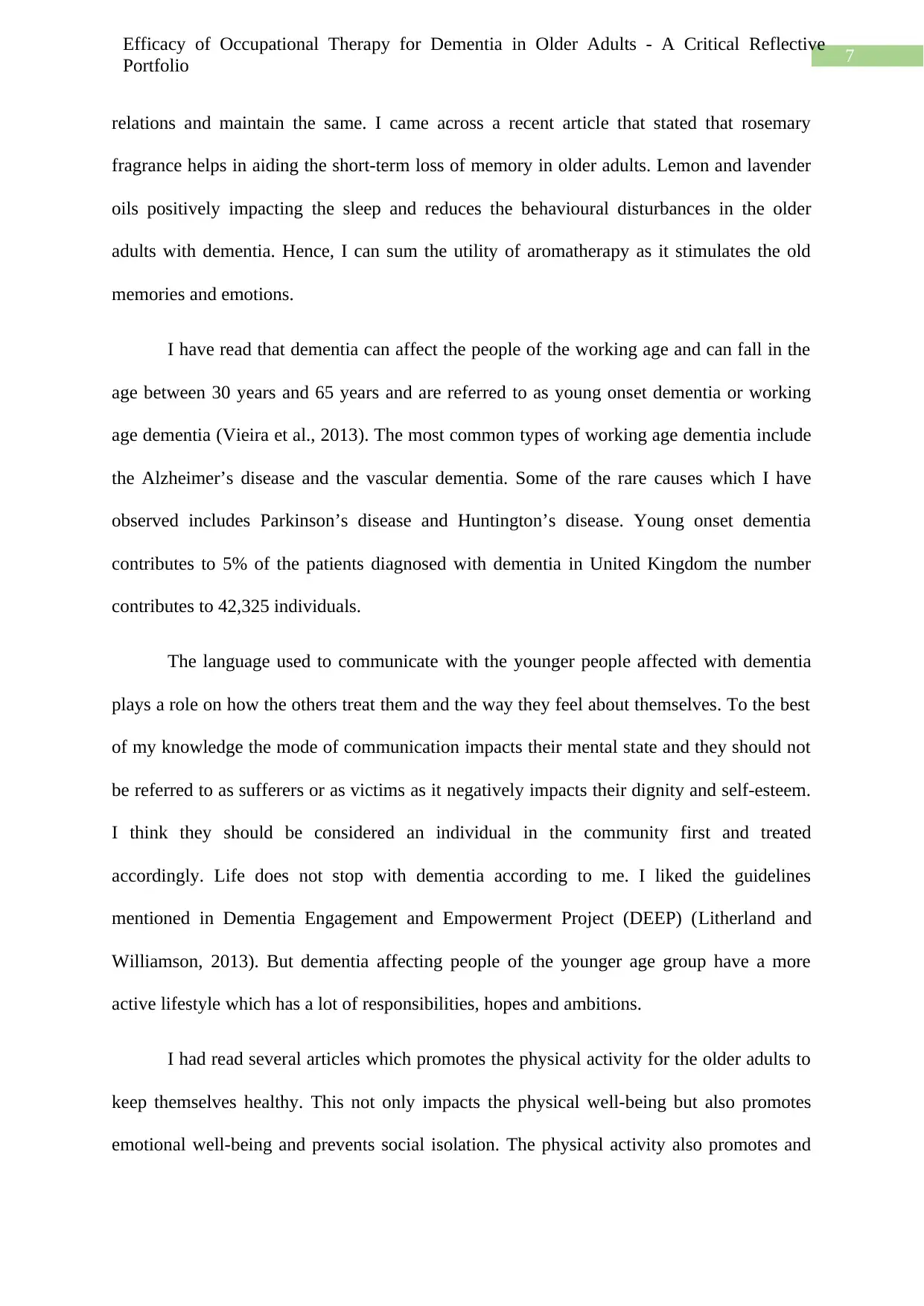
7
Efficacy of Occupational Therapy for Dementia in Older Adults - A Critical Reflective
Portfolio
relations and maintain the same. I came across a recent article that stated that rosemary
fragrance helps in aiding the short-term loss of memory in older adults. Lemon and lavender
oils positively impacting the sleep and reduces the behavioural disturbances in the older
adults with dementia. Hence, I can sum the utility of aromatherapy as it stimulates the old
memories and emotions.
I have read that dementia can affect the people of the working age and can fall in the
age between 30 years and 65 years and are referred to as young onset dementia or working
age dementia (Vieira et al., 2013). The most common types of working age dementia include
the Alzheimer’s disease and the vascular dementia. Some of the rare causes which I have
observed includes Parkinson’s disease and Huntington’s disease. Young onset dementia
contributes to 5% of the patients diagnosed with dementia in United Kingdom the number
contributes to 42,325 individuals.
The language used to communicate with the younger people affected with dementia
plays a role on how the others treat them and the way they feel about themselves. To the best
of my knowledge the mode of communication impacts their mental state and they should not
be referred to as sufferers or as victims as it negatively impacts their dignity and self-esteem.
I think they should be considered an individual in the community first and treated
accordingly. Life does not stop with dementia according to me. I liked the guidelines
mentioned in Dementia Engagement and Empowerment Project (DEEP) (Litherland and
Williamson, 2013). But dementia affecting people of the younger age group have a more
active lifestyle which has a lot of responsibilities, hopes and ambitions.
I had read several articles which promotes the physical activity for the older adults to
keep themselves healthy. This not only impacts the physical well-being but also promotes
emotional well-being and prevents social isolation. The physical activity also promotes and
Efficacy of Occupational Therapy for Dementia in Older Adults - A Critical Reflective
Portfolio
relations and maintain the same. I came across a recent article that stated that rosemary
fragrance helps in aiding the short-term loss of memory in older adults. Lemon and lavender
oils positively impacting the sleep and reduces the behavioural disturbances in the older
adults with dementia. Hence, I can sum the utility of aromatherapy as it stimulates the old
memories and emotions.
I have read that dementia can affect the people of the working age and can fall in the
age between 30 years and 65 years and are referred to as young onset dementia or working
age dementia (Vieira et al., 2013). The most common types of working age dementia include
the Alzheimer’s disease and the vascular dementia. Some of the rare causes which I have
observed includes Parkinson’s disease and Huntington’s disease. Young onset dementia
contributes to 5% of the patients diagnosed with dementia in United Kingdom the number
contributes to 42,325 individuals.
The language used to communicate with the younger people affected with dementia
plays a role on how the others treat them and the way they feel about themselves. To the best
of my knowledge the mode of communication impacts their mental state and they should not
be referred to as sufferers or as victims as it negatively impacts their dignity and self-esteem.
I think they should be considered an individual in the community first and treated
accordingly. Life does not stop with dementia according to me. I liked the guidelines
mentioned in Dementia Engagement and Empowerment Project (DEEP) (Litherland and
Williamson, 2013). But dementia affecting people of the younger age group have a more
active lifestyle which has a lot of responsibilities, hopes and ambitions.
I had read several articles which promotes the physical activity for the older adults to
keep themselves healthy. This not only impacts the physical well-being but also promotes
emotional well-being and prevents social isolation. The physical activity also promotes and
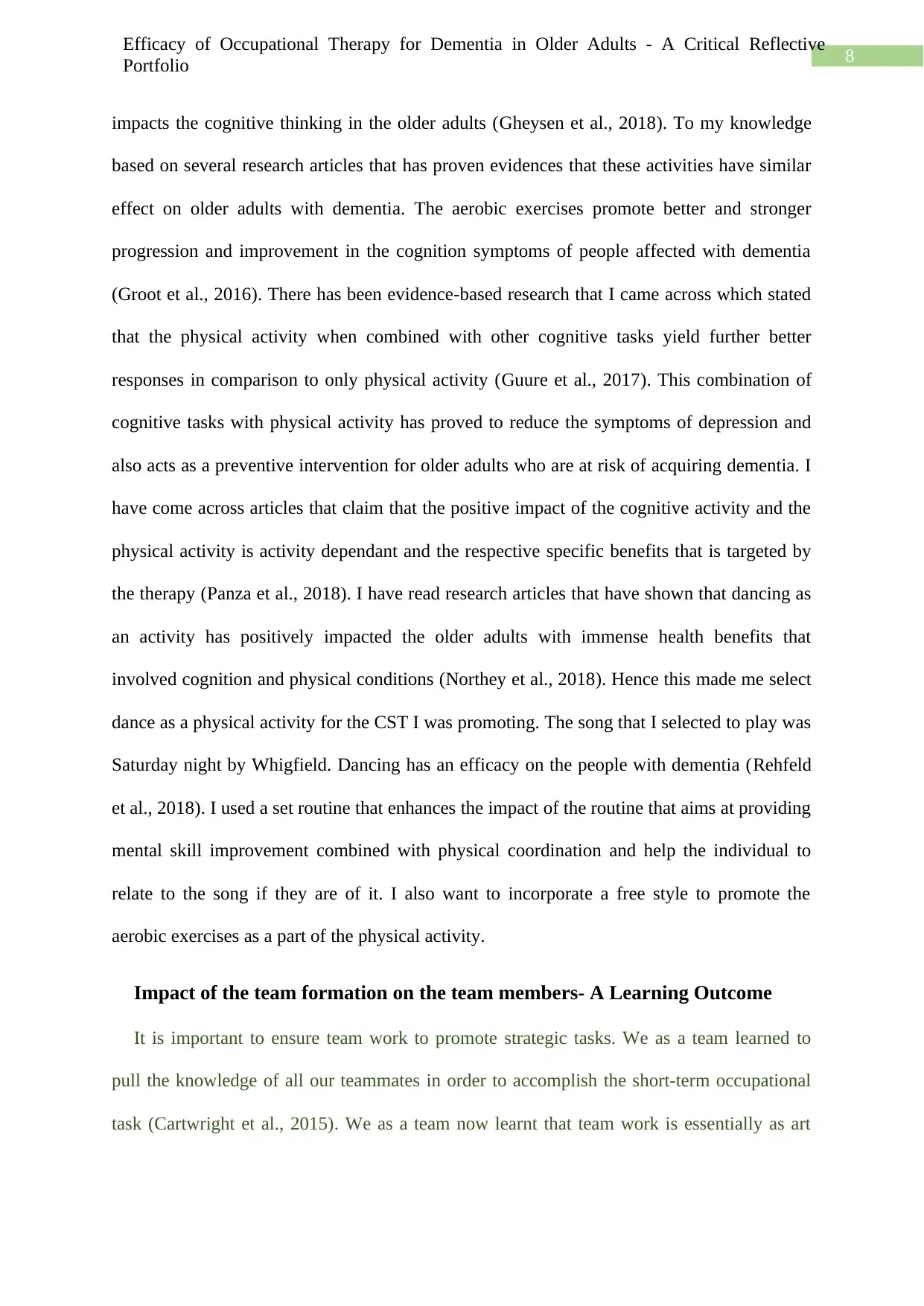
8
Efficacy of Occupational Therapy for Dementia in Older Adults - A Critical Reflective
Portfolio
impacts the cognitive thinking in the older adults (Gheysen et al., 2018). To my knowledge
based on several research articles that has proven evidences that these activities have similar
effect on older adults with dementia. The aerobic exercises promote better and stronger
progression and improvement in the cognition symptoms of people affected with dementia
(Groot et al., 2016). There has been evidence-based research that I came across which stated
that the physical activity when combined with other cognitive tasks yield further better
responses in comparison to only physical activity (Guure et al., 2017). This combination of
cognitive tasks with physical activity has proved to reduce the symptoms of depression and
also acts as a preventive intervention for older adults who are at risk of acquiring dementia. I
have come across articles that claim that the positive impact of the cognitive activity and the
physical activity is activity dependant and the respective specific benefits that is targeted by
the therapy (Panza et al., 2018). I have read research articles that have shown that dancing as
an activity has positively impacted the older adults with immense health benefits that
involved cognition and physical conditions (Northey et al., 2018). Hence this made me select
dance as a physical activity for the CST I was promoting. The song that I selected to play was
Saturday night by Whigfield. Dancing has an efficacy on the people with dementia (Rehfeld
et al., 2018). I used a set routine that enhances the impact of the routine that aims at providing
mental skill improvement combined with physical coordination and help the individual to
relate to the song if they are of it. I also want to incorporate a free style to promote the
aerobic exercises as a part of the physical activity.
Impact of the team formation on the team members- A Learning Outcome
It is important to ensure team work to promote strategic tasks. We as a team learned to
pull the knowledge of all our teammates in order to accomplish the short-term occupational
task (Cartwright et al., 2015). We as a team now learnt that team work is essentially as art
Efficacy of Occupational Therapy for Dementia in Older Adults - A Critical Reflective
Portfolio
impacts the cognitive thinking in the older adults (Gheysen et al., 2018). To my knowledge
based on several research articles that has proven evidences that these activities have similar
effect on older adults with dementia. The aerobic exercises promote better and stronger
progression and improvement in the cognition symptoms of people affected with dementia
(Groot et al., 2016). There has been evidence-based research that I came across which stated
that the physical activity when combined with other cognitive tasks yield further better
responses in comparison to only physical activity (Guure et al., 2017). This combination of
cognitive tasks with physical activity has proved to reduce the symptoms of depression and
also acts as a preventive intervention for older adults who are at risk of acquiring dementia. I
have come across articles that claim that the positive impact of the cognitive activity and the
physical activity is activity dependant and the respective specific benefits that is targeted by
the therapy (Panza et al., 2018). I have read research articles that have shown that dancing as
an activity has positively impacted the older adults with immense health benefits that
involved cognition and physical conditions (Northey et al., 2018). Hence this made me select
dance as a physical activity for the CST I was promoting. The song that I selected to play was
Saturday night by Whigfield. Dancing has an efficacy on the people with dementia (Rehfeld
et al., 2018). I used a set routine that enhances the impact of the routine that aims at providing
mental skill improvement combined with physical coordination and help the individual to
relate to the song if they are of it. I also want to incorporate a free style to promote the
aerobic exercises as a part of the physical activity.
Impact of the team formation on the team members- A Learning Outcome
It is important to ensure team work to promote strategic tasks. We as a team learned to
pull the knowledge of all our teammates in order to accomplish the short-term occupational
task (Cartwright et al., 2015). We as a team now learnt that team work is essentially as art
⊘ This is a preview!⊘
Do you want full access?
Subscribe today to unlock all pages.

Trusted by 1+ million students worldwide
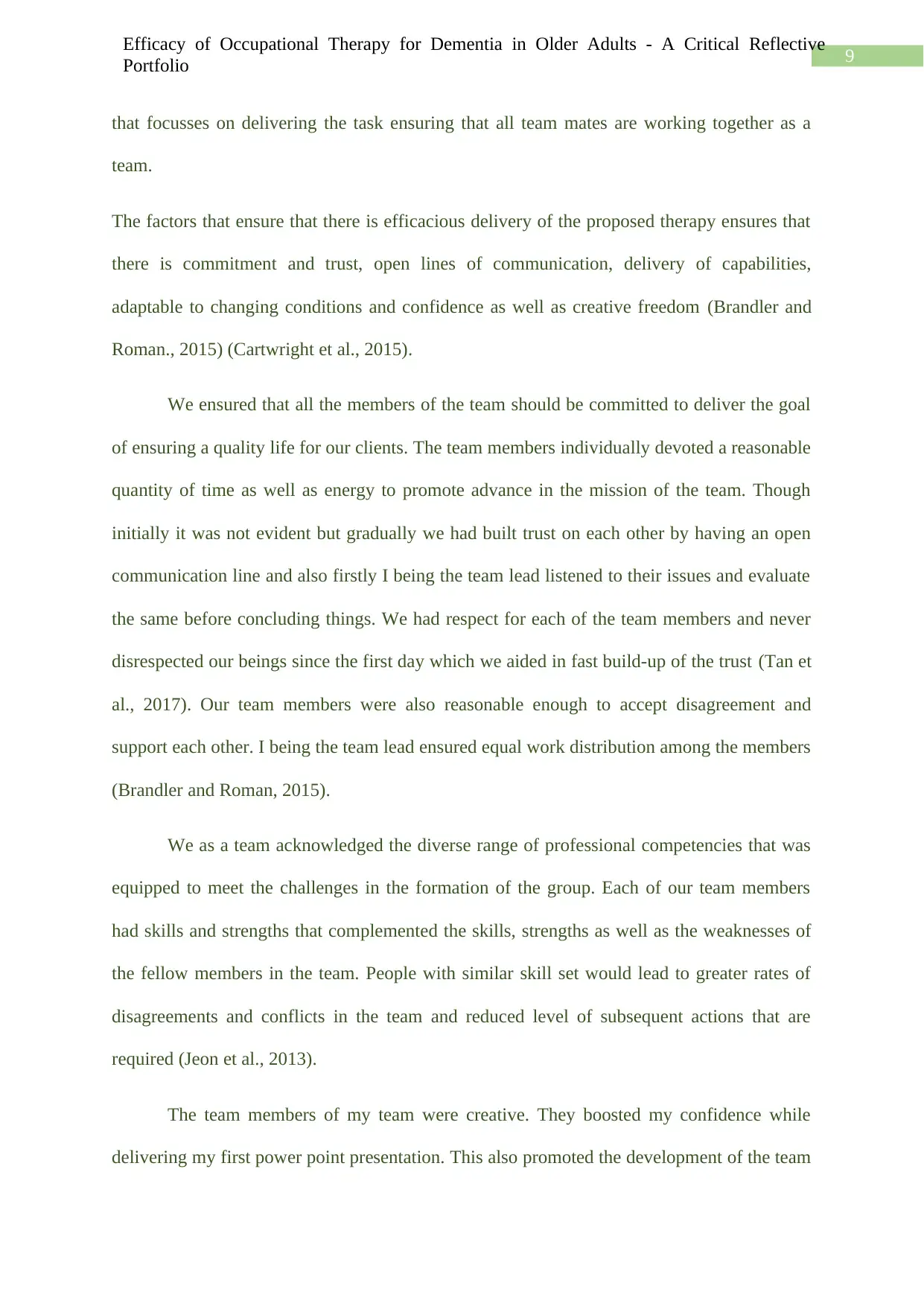
9
Efficacy of Occupational Therapy for Dementia in Older Adults - A Critical Reflective
Portfolio
that focusses on delivering the task ensuring that all team mates are working together as a
team.
The factors that ensure that there is efficacious delivery of the proposed therapy ensures that
there is commitment and trust, open lines of communication, delivery of capabilities,
adaptable to changing conditions and confidence as well as creative freedom (Brandler and
Roman., 2015) (Cartwright et al., 2015).
We ensured that all the members of the team should be committed to deliver the goal
of ensuring a quality life for our clients. The team members individually devoted a reasonable
quantity of time as well as energy to promote advance in the mission of the team. Though
initially it was not evident but gradually we had built trust on each other by having an open
communication line and also firstly I being the team lead listened to their issues and evaluate
the same before concluding things. We had respect for each of the team members and never
disrespected our beings since the first day which we aided in fast build-up of the trust (Tan et
al., 2017). Our team members were also reasonable enough to accept disagreement and
support each other. I being the team lead ensured equal work distribution among the members
(Brandler and Roman, 2015).
We as a team acknowledged the diverse range of professional competencies that was
equipped to meet the challenges in the formation of the group. Each of our team members
had skills and strengths that complemented the skills, strengths as well as the weaknesses of
the fellow members in the team. People with similar skill set would lead to greater rates of
disagreements and conflicts in the team and reduced level of subsequent actions that are
required (Jeon et al., 2013).
The team members of my team were creative. They boosted my confidence while
delivering my first power point presentation. This also promoted the development of the team
Efficacy of Occupational Therapy for Dementia in Older Adults - A Critical Reflective
Portfolio
that focusses on delivering the task ensuring that all team mates are working together as a
team.
The factors that ensure that there is efficacious delivery of the proposed therapy ensures that
there is commitment and trust, open lines of communication, delivery of capabilities,
adaptable to changing conditions and confidence as well as creative freedom (Brandler and
Roman., 2015) (Cartwright et al., 2015).
We ensured that all the members of the team should be committed to deliver the goal
of ensuring a quality life for our clients. The team members individually devoted a reasonable
quantity of time as well as energy to promote advance in the mission of the team. Though
initially it was not evident but gradually we had built trust on each other by having an open
communication line and also firstly I being the team lead listened to their issues and evaluate
the same before concluding things. We had respect for each of the team members and never
disrespected our beings since the first day which we aided in fast build-up of the trust (Tan et
al., 2017). Our team members were also reasonable enough to accept disagreement and
support each other. I being the team lead ensured equal work distribution among the members
(Brandler and Roman, 2015).
We as a team acknowledged the diverse range of professional competencies that was
equipped to meet the challenges in the formation of the group. Each of our team members
had skills and strengths that complemented the skills, strengths as well as the weaknesses of
the fellow members in the team. People with similar skill set would lead to greater rates of
disagreements and conflicts in the team and reduced level of subsequent actions that are
required (Jeon et al., 2013).
The team members of my team were creative. They boosted my confidence while
delivering my first power point presentation. This also promoted the development of the team
Paraphrase This Document
Need a fresh take? Get an instant paraphrase of this document with our AI Paraphraser
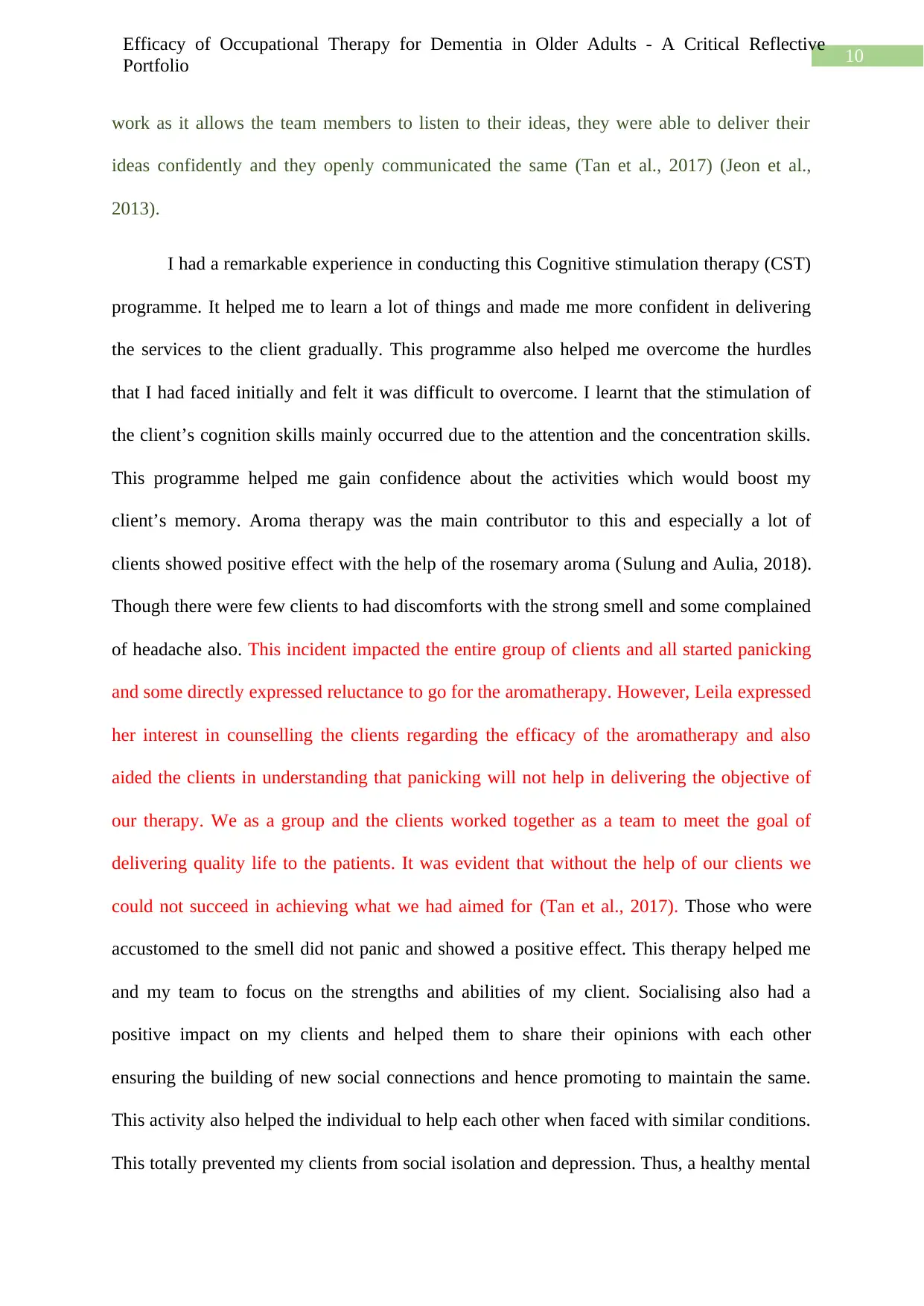
10
Efficacy of Occupational Therapy for Dementia in Older Adults - A Critical Reflective
Portfolio
work as it allows the team members to listen to their ideas, they were able to deliver their
ideas confidently and they openly communicated the same (Tan et al., 2017) (Jeon et al.,
2013).
I had a remarkable experience in conducting this Cognitive stimulation therapy (CST)
programme. It helped me to learn a lot of things and made me more confident in delivering
the services to the client gradually. This programme also helped me overcome the hurdles
that I had faced initially and felt it was difficult to overcome. I learnt that the stimulation of
the client’s cognition skills mainly occurred due to the attention and the concentration skills.
This programme helped me gain confidence about the activities which would boost my
client’s memory. Aroma therapy was the main contributor to this and especially a lot of
clients showed positive effect with the help of the rosemary aroma (Sulung and Aulia, 2018).
Though there were few clients to had discomforts with the strong smell and some complained
of headache also. This incident impacted the entire group of clients and all started panicking
and some directly expressed reluctance to go for the aromatherapy. However, Leila expressed
her interest in counselling the clients regarding the efficacy of the aromatherapy and also
aided the clients in understanding that panicking will not help in delivering the objective of
our therapy. We as a group and the clients worked together as a team to meet the goal of
delivering quality life to the patients. It was evident that without the help of our clients we
could not succeed in achieving what we had aimed for (Tan et al., 2017). Those who were
accustomed to the smell did not panic and showed a positive effect. This therapy helped me
and my team to focus on the strengths and abilities of my client. Socialising also had a
positive impact on my clients and helped them to share their opinions with each other
ensuring the building of new social connections and hence promoting to maintain the same.
This activity also helped the individual to help each other when faced with similar conditions.
This totally prevented my clients from social isolation and depression. Thus, a healthy mental
Efficacy of Occupational Therapy for Dementia in Older Adults - A Critical Reflective
Portfolio
work as it allows the team members to listen to their ideas, they were able to deliver their
ideas confidently and they openly communicated the same (Tan et al., 2017) (Jeon et al.,
2013).
I had a remarkable experience in conducting this Cognitive stimulation therapy (CST)
programme. It helped me to learn a lot of things and made me more confident in delivering
the services to the client gradually. This programme also helped me overcome the hurdles
that I had faced initially and felt it was difficult to overcome. I learnt that the stimulation of
the client’s cognition skills mainly occurred due to the attention and the concentration skills.
This programme helped me gain confidence about the activities which would boost my
client’s memory. Aroma therapy was the main contributor to this and especially a lot of
clients showed positive effect with the help of the rosemary aroma (Sulung and Aulia, 2018).
Though there were few clients to had discomforts with the strong smell and some complained
of headache also. This incident impacted the entire group of clients and all started panicking
and some directly expressed reluctance to go for the aromatherapy. However, Leila expressed
her interest in counselling the clients regarding the efficacy of the aromatherapy and also
aided the clients in understanding that panicking will not help in delivering the objective of
our therapy. We as a group and the clients worked together as a team to meet the goal of
delivering quality life to the patients. It was evident that without the help of our clients we
could not succeed in achieving what we had aimed for (Tan et al., 2017). Those who were
accustomed to the smell did not panic and showed a positive effect. This therapy helped me
and my team to focus on the strengths and abilities of my client. Socialising also had a
positive impact on my clients and helped them to share their opinions with each other
ensuring the building of new social connections and hence promoting to maintain the same.
This activity also helped the individual to help each other when faced with similar conditions.
This totally prevented my clients from social isolation and depression. Thus, a healthy mental
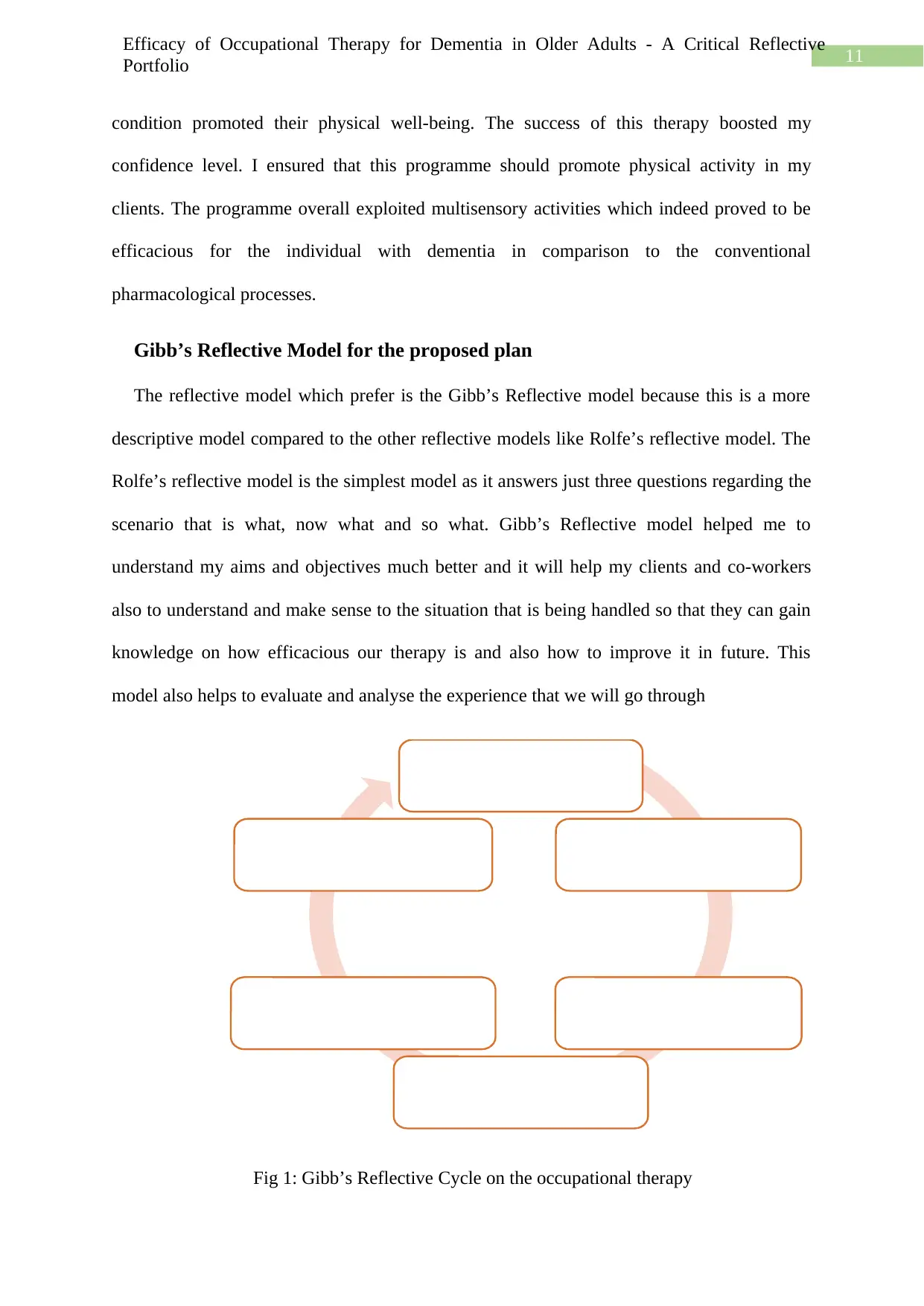
11
Efficacy of Occupational Therapy for Dementia in Older Adults - A Critical Reflective
Portfolio
condition promoted their physical well-being. The success of this therapy boosted my
confidence level. I ensured that this programme should promote physical activity in my
clients. The programme overall exploited multisensory activities which indeed proved to be
efficacious for the individual with dementia in comparison to the conventional
pharmacological processes.
Gibb’s Reflective Model for the proposed plan
The reflective model which prefer is the Gibb’s Reflective model because this is a more
descriptive model compared to the other reflective models like Rolfe’s reflective model. The
Rolfe’s reflective model is the simplest model as it answers just three questions regarding the
scenario that is what, now what and so what. Gibb’s Reflective model helped me to
understand my aims and objectives much better and it will help my clients and co-workers
also to understand and make sense to the situation that is being handled so that they can gain
knowledge on how efficacious our therapy is and also how to improve it in future. This
model also helps to evaluate and analyse the experience that we will go through
Fig 1: Gibb’s Reflective Cycle on the occupational therapy
Dementia- A global concern
Help increase the quality of life
of the affected individual
The initial non adherence to the
therapy was a concren but the
gradual effectivity of the training
was appreciable
The visible improvement of the
cognitive characters in my
clients
Development and Promotion of
CST in large scale
Promotion of Dementia friendly
communities
Efficacy of Occupational Therapy for Dementia in Older Adults - A Critical Reflective
Portfolio
condition promoted their physical well-being. The success of this therapy boosted my
confidence level. I ensured that this programme should promote physical activity in my
clients. The programme overall exploited multisensory activities which indeed proved to be
efficacious for the individual with dementia in comparison to the conventional
pharmacological processes.
Gibb’s Reflective Model for the proposed plan
The reflective model which prefer is the Gibb’s Reflective model because this is a more
descriptive model compared to the other reflective models like Rolfe’s reflective model. The
Rolfe’s reflective model is the simplest model as it answers just three questions regarding the
scenario that is what, now what and so what. Gibb’s Reflective model helped me to
understand my aims and objectives much better and it will help my clients and co-workers
also to understand and make sense to the situation that is being handled so that they can gain
knowledge on how efficacious our therapy is and also how to improve it in future. This
model also helps to evaluate and analyse the experience that we will go through
Fig 1: Gibb’s Reflective Cycle on the occupational therapy
Dementia- A global concern
Help increase the quality of life
of the affected individual
The initial non adherence to the
therapy was a concren but the
gradual effectivity of the training
was appreciable
The visible improvement of the
cognitive characters in my
clients
Development and Promotion of
CST in large scale
Promotion of Dementia friendly
communities
⊘ This is a preview!⊘
Do you want full access?
Subscribe today to unlock all pages.

Trusted by 1+ million students worldwide
1 out of 20
Your All-in-One AI-Powered Toolkit for Academic Success.
+13062052269
info@desklib.com
Available 24*7 on WhatsApp / Email
![[object Object]](/_next/static/media/star-bottom.7253800d.svg)
Unlock your academic potential
Copyright © 2020–2025 A2Z Services. All Rights Reserved. Developed and managed by ZUCOL.
